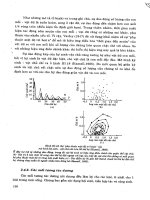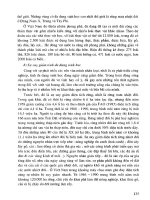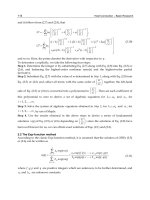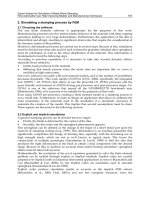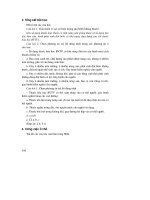Volume 10 - Materials Characterization Part 6 pot
Bạn đang xem bản rút gọn của tài liệu. Xem và tải ngay bản đầy đủ của tài liệu tại đây (1.17 MB, 90 trang )
tertiary
p
References cited in this section
Determination of Organic Compounds: Methods and Procedures,
Determination of Organic Compounds: Methods and Procedures,
Anal. Chem.,
Determination of Organic Compounds: Methods and Procedures,
J. Biol. Chem.,
J. Biol. Chem.,
Mikrochim. Acta,
J. Am. Chem. Soc.,
Anal. Lett.,
Anal. Chem.,
Chem. Rev.,
Analytical Chemistry of Polycyclic Aromatic Hydrocarbons,
Anal. Chem.,
Fuel,
The Systematic Identification of Organic
Compounds,
Ind. Eng. Chem., Anal. Ed.,
J. Org. Chem.,
J. Org. Chem.,
Talanta,
J. Chromatography,
Note cited in this section
Elemental and Functional Group Analysis
Walter T. Smith, Jr., Department of Chemistry, University of Kentucky
Karl Fischer Method for Water Determination
References cited in this section
Z. Angew. Chem.,
Aquametry,
Anal. Chem.,
Fresenius Z. Anal. Chem.,
Anal. Chem.,
Elemental and Functional Group Analysis
Walter T. Smith, Jr., Department of Chemistry, University of Kentucky
Unsaturation (Alkenes)
References cited in this section
Determination of Organic Compounds: Methods and Procedures,
Fatty Acids,
Anal. Chem.,
Elemental and Functional Group Analysis
Walter T. Smith, Jr., Department of Chemistry, University of Kentucky
References
Modern Organic Elemental Analysis,
Advances in Analytical Chemistry and Instrumentation,
Mikrochim. Acta,
Determination of Organic Compounds: Methods and Procedures,
Determination of Organic Compounds: Methods and Procedures,
Anal. Chem.,
Determination of Organic Compounds: Methods and Procedures,
J. Biol. Chem.,
J. Biol. Chem.,
Mikrochim. Acta,
J. Am. Chem. Soc.,
J. Am. Chem. Soc.,
Anal. Lett.,
Anal. Chem.,
Chem. Rev.,
Analytical Chemistry of Polycyclic Aromatic Hydrocarbons,
Anal. Chem.,
Fuel,
The Systematic Identification of Organic
Compounds,
Ind. Eng. Chem., Anal. Ed.,
J. Org. Chem.,
J. Org. Chem.,
Talanta,
J. Chromatography,
Z. Angew. Chem.,
Aquametry,
Anal. Chem.,
Fresenius Z. Anal. Chem.,
Anal. Chem.,
Determination of Organic Compounds: Methods and Procedures,
Fatty Acids,
Anal. Chem.,
Elemental and Functional Group Analysis
Walter T. Smith, Jr., Department of Chemistry, University of Kentucky
Selected References
Treatise on Analytical Chemistry,
Analytical Chemistry of
Inorganic and Organic Compounds,
Instrumental Methods of Organic Functional Group Analysis,
Analytical Chemistry of Nitrogen and its Compounds,
Chemical
Analysis,
Determination of Organic Compounds: Methods and Procedures, Chemical Analysis
High-Temperature Combustion
R.B. Fricioni and Loren Essig, Leco Corporation
General Use
•
Samples
• Form:
• Size:
• Preparation:
Limitations
•
•
•
Estimated Analysis Time
• Sample preparation:
• Analysis time:
Capabilities of Related Techniques
• Optical emission:
• X-ray fluorescence:
High-Temperature Combustion
R.B. Fricioni and Loren Essig, Leco Corporation
Introduction
High-Temperature Combustion
R.B. Fricioni and Loren Essig, Leco Corporation
Combustion Principles
Accelerators
Table 1 Combustion accelerators
Accelerator
Good combustion aid for steel, iron, and nonferrous metals and alloys in a high-frequency furnace for
determination of percent carbon; may be combined with iron chips for nonferrous alloys; may be combined with
tin chips on some systems for sulfur determination
Same guidelines as copper chips, but used with resistance furnace systems
Good accelerator for combusting steel, iron, or nonferrous metals and alloys for determination of carbon or sulfur;
when analyzing for concentrations below 0.05% C and 0.002% S, high-grade iron chips should be used to provide
consistent results; iron chips must be used when combusting nonferrous materials in a high-frequency furnace
system
Fig. 1 Typical high-frequency combustion configuration.
Good additive accelerator for combustion of steel, iron, and nonferrous materials; tin chips have relatively low
combustion point and assist in the initial stages of combustion by generating a higher temperature at an earlier
stage
Tungsten Good accelerator for most steels, irons, and nonferrous materials; provides excellent combustion when combined
with tin chips; used primarily where very low carbon and sulfur concentrations are being determined
High-Temperature Combustion
R.B. Fricioni and Loren Essig, Leco Corporation
Separation of Interfering Elements
High-Temperature Combustion
R.B. Fricioni and Loren Essig, Leco Corporation
Detection of Combustion Products
Infrared detection
Thermal-conductive detection
Table 2 Thermal conductivity of gases
Gas
150
39
33
10.4
5.7
5.6
5.4
5.4
3.8
3.3
Sulfur dioxide 1.6
High-Temperature Combustion
R.B. Fricioni and Loren Essig, Leco Corporation
Total and Selective Combustion
v w
Total combustion
Selective combustion
High-Temperature Combustion
R.B. Fricioni and Loren Essig, Leco Corporation
Applications
Example 1.
Example 2.
Example 3.
High-Temperature Combustion
R.B. Fricioni and Loren Essig, Leco Corporation
Selected References
Catalysis and Inhibition of Chemical Reactions,
Chemisorption,
Adsorption,
Coal Testing Conference Proceedings,
Inert Gas Fusion
R.B. Fricioni and Loren Essig, Leco Corporation
General Use
•
Samples
• Form:
• Size:
• Preparation:
Limitations
•
•
•
Estimated Analysis Time
•
Capabilities of Related Techniques
• Vacuum fusion:
• Hot extraction:
• Optical and mass spectroscopy:
Inert Gas Fusion
R.B. Fricioni and Loren Essig, Leco Corporation
Introduction
Inert Gas Fusion
R.B. Fricioni and Loren Essig, Leco Corporation
Principles of Operation
Fig. 1 Graphite crucibles used in inert gas fusion analysis.
Fig. 2 Simplified impulse inert gas fusion furnace. The graphite crucible acts as a resistor, completing a high-
current circuit and reaching 3000 °C (5430 °F).
Fig. 3 Simplified inductive inert gas fusion furnace. The graphite crucible acts as an inductor in a high-
frequency induction furnace, reaching 2500 °C (4530 °F).
Inert Gas Fusion
R.B. Fricioni and Loren Essig, Leco Corporation
Separation of Fusion Gases
Fig. 4
Inert gas fusion system for detecting nitrogen and oxygen. 1, Helium supply; 2, pressure regulator; 3,
heated copper; 4, NaOH-impregnated clay; 5, Mg(ClO
4
)
2
desiccant; 6, flow control; 7, flow manifold; 8, gas
doser (optional); 9, sample holding chamber; 10, electrode (impulse) furnace; 11, dust filter; 12, heated rare
earth copper oxide; 13, Mg(ClO
4
)
2
desiccant; 14, silica gel column; 15, thermal conductiv
e detector/readout;
16, flow rotameter
Fig. 5 Insert gas fusion system for detecting nitrogen and oxygen. 1, Helium supply; 2, two-
stage pressure
regulator; 3, NaOH-impregnated clay; 4, Mg(ClO
4
)
2
desiccant; 5, flow restrictor; 6, flow meter; 7, pressure
regulator; 8, needle valve; 9, gas doser (optional); 10, flow manifold; 11, sample holding chamber; 12,
electrode (impulse) fur
nace; 13, dust filter; 14, heated rare earth copper oxide; 15, flow control; 16, infrared
detector/readout; 17, thermal-conductive detector/readout
Inert Gas Fusion
R.B. Fricioni and Loren Essig, Leco Corporation
Detection of Fusion Gases
Thermal-conductive detection
Table 1 Thermal conductivity of gases
Gas Molecular
weight
150
39
33
10.4
5.7
5.6
5.4
5.4
3.8
3.3
Sulfur dioxide 64 1.6
Fig. 6 Typical thermal-conductive detection cell.
Infrared Detection.
Inert Gas Fusion
R.B. Fricioni and Loren Essig, Leco Corporation
Determination of Gases
Nitrogen Determination.
Oxygen analysis
Hydrogen analysis
Fig. 7 Typical infrared detection system.
Inert Gas Fusion
R.B. Fricioni and Loren Essig, Leco Corporation
Samples
Inert Gas Fusion
R.B. Fricioni and Loren Essig, Leco Corporation
Selective Fusion

